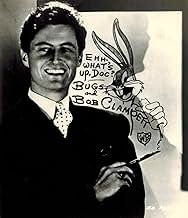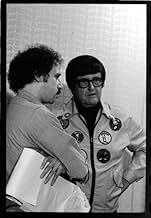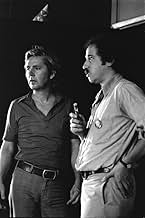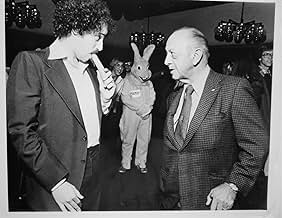Agrega una trama en tu idiomaLooney Tunes documentary film hosted by Bob Clampett, including nine complete cartoons from the 40s and the artists behind the characters.Looney Tunes documentary film hosted by Bob Clampett, including nine complete cartoons from the 40s and the artists behind the characters.Looney Tunes documentary film hosted by Bob Clampett, including nine complete cartoons from the 40s and the artists behind the characters.
Orson Welles
- Narrator
- (voz)
Robert Clampett
- Self
- (as Bob Clampett)
Arthur Q. Bryan
- Elmer Fudd
- (voz)
- (sin créditos)
Opiniones destacadas
I'm surprised to read so few comments about Bugs Bunny, Superstar. So I'll chime in. Besides, it'll give me som'in' positive to say. They're all here - not just Bugs. This nine-cartoon compilation also features Elmer Fudd, Tweety, Silvester, Henry-the-Chicken-Hawk, Foghorn Leghorn, Porky, Daffy. It's kind of a "Best of." I thought that it was very, very good. There is some narration by Orson Welles and the difficult-to-pull-off segue from cartoon to cartoon is filled by interesting home-movie-type, black-and-white glimpses of how it was where the comics were created - the people behind the characters - the artists, the musicians, the voice (singular - Mel Blanc). But imagine this: I didn't hear the word "computer" during the entire film! This is one of the few videos that I would actually buy - I could watch it over and over. Must be the kid in me. Speaking of kids, I'll bet there's generations of 'em, the majority of whom have seen Bugs, Elmer, Porky, Daffy, Tweety, Sylvester. But I'll also bet that the majority of CURRENT cartoons are NOT known from generation to generation. Might that be a testament to how deservingly enduring these Looney Toons are?
Documentary on the creators of Looney Tunes and how they created the various characters. Intespersed are some great cartoons--6 Bugs Bunny ones, a Tweety Bird one, a Foghorn Leghorn one and a Porky Pig and Daffy one.
The documentary is narrated by Orson Welles (!!!!). It might have seemed like a good idea but his deep, heavy voice and total inability to tell a joke correctly really dampens it. There are some interesting little tidbits about Looney Tunes--how they were originally made just for adults and how there was a big outcry when people realized Tweety Bird was naked (!!!). But the real reason to see this are the cartoons. They're in great shape in strong, bright colors. Also they show ones that don't usually appear at other retrospectives--I only recognized 2 of the Bugs Bunny ones. All of them are great but "Carny Concereto" and "Rhapsody Rabbit" are exceptional.
Ignore the docu stuff and concentrate on the cartoons. Lots of fun!
The documentary is narrated by Orson Welles (!!!!). It might have seemed like a good idea but his deep, heavy voice and total inability to tell a joke correctly really dampens it. There are some interesting little tidbits about Looney Tunes--how they were originally made just for adults and how there was a big outcry when people realized Tweety Bird was naked (!!!). But the real reason to see this are the cartoons. They're in great shape in strong, bright colors. Also they show ones that don't usually appear at other retrospectives--I only recognized 2 of the Bugs Bunny ones. All of them are great but "Carny Concereto" and "Rhapsody Rabbit" are exceptional.
Ignore the docu stuff and concentrate on the cartoons. Lots of fun!
When I was five, I first saw the documentary "Bugs Bunny Superstar" and my parents made me a tape of it; unfortunately, we accidentally taped over the end. Now that I've seen the whole thing again - and that I'm old enough to understand what it shows - I can accurately comment on it.
It starts with a disembodied voice (actually Orson Welles narrating) showing photographs of the places representing the greatest minds: the Great Wall of China, the Taj Mahal, the Pyramids, the Parthenon, the Coliseum, the Eiffel Tower, the White House (well, not currently), Termite Terrace...wait a minute, Termite Terrace? Yes, Termite Terrace. For the uninformed, it's the back-lot on the Warner Bros. studios where they created the Looney Tunes/Merrie Melodies cartoons. So begins a cinematic trip down Memory Lane.
The movie consists of an interview with animator Bob Clampett explaining how they created Bugs, Daffy, Porky, etc. When I was really young, even though I saw the caricatures of Humphrey Bogart, Peter Lorre and Edward G. Robinson - plus the scenes from "The Jazz Singer" and "It Happened One Night" - I couldn't interpret anything from them, but of course now I can. It was especially neat to hear about the typical days in Termite Terrace; it all sounded really fun! But of course, the best parts are the nine classic cartoons included in the movie to affirm what Clampett says. All released before 1948, they give one a true sense of old-time cinema (especially with Bugs Bunny at the Oscars). As it is, this documentary's 1975 release brings to mind the '50s nostalgia that had swept the country, as displayed by "Happy Days". While the stuff portrayed here is pre-'50s, it still makes one nostalgic for the old times. You're sure to have a real hare-raising time! There's also an interview with Friz Freleng, some footage of Mel Blanc, while Elmer, Sylvester, Tweety, and Foghorn also appear in the cartoons.
One more thing. When MGM released "Bugs Bunny Superstar" on video in 1988, they also released the video collections "BUGS!" (whose cover showed Bugs holding an Oscar), "DAFFY!" (showing Daffy wearing sunglasses), "PORKY!" (showing Porky driving a fancy car), and "ELMER!" (showing Elmer sitting in a director's chair). In keeping with the documentary, they all contained cartoons released before or during 1948 (e.g., "Bugs Bunny Gets the Boid", "The Great Piggy Bank Robbery", "Baby Bottleneck" and "Good Night, Elmer"). I wonder why MGM released them onto video.
It starts with a disembodied voice (actually Orson Welles narrating) showing photographs of the places representing the greatest minds: the Great Wall of China, the Taj Mahal, the Pyramids, the Parthenon, the Coliseum, the Eiffel Tower, the White House (well, not currently), Termite Terrace...wait a minute, Termite Terrace? Yes, Termite Terrace. For the uninformed, it's the back-lot on the Warner Bros. studios where they created the Looney Tunes/Merrie Melodies cartoons. So begins a cinematic trip down Memory Lane.
The movie consists of an interview with animator Bob Clampett explaining how they created Bugs, Daffy, Porky, etc. When I was really young, even though I saw the caricatures of Humphrey Bogart, Peter Lorre and Edward G. Robinson - plus the scenes from "The Jazz Singer" and "It Happened One Night" - I couldn't interpret anything from them, but of course now I can. It was especially neat to hear about the typical days in Termite Terrace; it all sounded really fun! But of course, the best parts are the nine classic cartoons included in the movie to affirm what Clampett says. All released before 1948, they give one a true sense of old-time cinema (especially with Bugs Bunny at the Oscars). As it is, this documentary's 1975 release brings to mind the '50s nostalgia that had swept the country, as displayed by "Happy Days". While the stuff portrayed here is pre-'50s, it still makes one nostalgic for the old times. You're sure to have a real hare-raising time! There's also an interview with Friz Freleng, some footage of Mel Blanc, while Elmer, Sylvester, Tweety, and Foghorn also appear in the cartoons.
One more thing. When MGM released "Bugs Bunny Superstar" on video in 1988, they also released the video collections "BUGS!" (whose cover showed Bugs holding an Oscar), "DAFFY!" (showing Daffy wearing sunglasses), "PORKY!" (showing Porky driving a fancy car), and "ELMER!" (showing Elmer sitting in a director's chair). In keeping with the documentary, they all contained cartoons released before or during 1948 (e.g., "Bugs Bunny Gets the Boid", "The Great Piggy Bank Robbery", "Baby Bottleneck" and "Good Night, Elmer"). I wonder why MGM released them onto video.
This superb compilation, appropriately narrated by another American cultural giant, Orson Welles, features the best of the 1940s Looney Tunes output, not just Bugs, but Sylvester, Tweetie, Daffy, Porky and Foghorn: 'What's Cookin' Doc', 'A Wild Hare', 'A Corny Concerto', 'Rhapsody Rabbit', 'I Saw A Putty Tat', 'Walky Talky Hawky', 'My Favorite Duck', 'Hair Raising Hare' and ''Old Grey Hare' (see my individual reviews).
As a piece of cultural history, this semi-documentary is inadequate - there is no attempt to explain the subversiveness of these irreverent, flippant, violent, beautiful cartoons in the context of Disney-dominating ick-animation and gloomy, propaganda-laden World War Two - to which many of these cartoons tacitly refer, revealing complicated truths other 'real' films couldn't dare, such as the barbaric effect fighting barbarians can have on 'our' side; there is no analysis of the glorious pretention-pricking of both Hollywood and high culture, or Bugs' androgynous proteanism, or how the cartoons retained a level of fresh invention while seemingly locked in repetitive formulae; of the powerful psychoanalytic premisses of each short, in which a wild, elusive, lawless animal stands in for our stifled desires, especially as World War Two gives on to the post-war world of Joe McCarthy and chums.
Rather, the in-between nostalgic bits celebrate harmless anecdote and japery, putting animation on its proper, neutered level. The cartoons themselves triumphantly bely such a project.
As a piece of cultural history, this semi-documentary is inadequate - there is no attempt to explain the subversiveness of these irreverent, flippant, violent, beautiful cartoons in the context of Disney-dominating ick-animation and gloomy, propaganda-laden World War Two - to which many of these cartoons tacitly refer, revealing complicated truths other 'real' films couldn't dare, such as the barbaric effect fighting barbarians can have on 'our' side; there is no analysis of the glorious pretention-pricking of both Hollywood and high culture, or Bugs' androgynous proteanism, or how the cartoons retained a level of fresh invention while seemingly locked in repetitive formulae; of the powerful psychoanalytic premisses of each short, in which a wild, elusive, lawless animal stands in for our stifled desires, especially as World War Two gives on to the post-war world of Joe McCarthy and chums.
Rather, the in-between nostalgic bits celebrate harmless anecdote and japery, putting animation on its proper, neutered level. The cartoons themselves triumphantly bely such a project.
10dcjc
A great movie documentary telling of the early days of the Warner Brothers toon studios (think of "Termite Terrace" as you watch), along with nine great toon shorts the family will love for a long time to come.
This movie should be watched for on Showtime (or any of its other channels). Too bad it's not on video now--it should be taped!
I must agree, it's a family film that indeed shall be grater than any others that will proclaim so in future.
So long live BUGS...long live the MERRIE MELODIES...and LONG LIVE THE LOONEY TUNES!!
An agreeable 10\10 effort from the United Artists team.
This movie should be watched for on Showtime (or any of its other channels). Too bad it's not on video now--it should be taped!
I must agree, it's a family film that indeed shall be grater than any others that will proclaim so in future.
So long live BUGS...long live the MERRIE MELODIES...and LONG LIVE THE LOONEY TUNES!!
An agreeable 10\10 effort from the United Artists team.
¿Sabías que…?
- TriviaIncludes the following cartoons in their entirety: What's Cookin' Doc? (1944), A Wild Hare (1940), Un Concierto En El Carne y Frijol (1943), I Taw a Putty Tat (1948), El Gran Concierto (1946), Cazando Pollos al Amanecer (1946), My Favorite Duck (1942), El Gran Científico (1946) and The Old Grey Hare (1944).
- ErroresAbraham Lincoln was born in Kentucky, not Illinois.
- Versiones alternativasOn the 2006 Warner Bros. DVD, a two-part special feature in the box set Looney Tunes Golden Collection: Volume 4, all but two cartoons were replaced by versions created by Turner Entertainment in 1995. The Old Grey Hare used an original a.a.p. print (evidenced by the a.a.p. opening soundtrack) to preserve the ending gag involving the "That's all, Folks" title card, which was lost in the Turner updated version. I Taw a Putty Tat was also restored to the a.a.p. print, as the Turner version contained an edit to remove a blackface gag. Aside from leaving in the edited scene, however, the print on the set is basically the same as the Turner version.
- ConexionesEdited from El cantante de jazz (1927)
- Bandas sonorasChew Turn Me On
Written by Robert Clampett (as Bob Clampett) and Ian Whitcomb
Selecciones populares
Inicia sesión para calificar y agrega a la lista de videos para obtener recomendaciones personalizadas
Detalles
- Fecha de lanzamiento
- País de origen
- Idioma
- También se conoce como
- Багз Банни суперзвезда
- Productora
- Ver más créditos de la compañía en IMDbPro
Contribuir a esta página
Sugiere una edición o agrega el contenido que falta





















